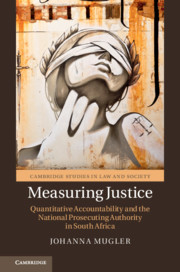 Measuring Justice
Measuring Justice Published online by Cambridge University Press: 22 June 2019
Social scientific studies, which focus on the effects of performance indicators and rankings on specific organisational fields, often include accounts of individual professionals whose reaction and attitude towards performance measurement can be summarised as critical, cynical and sometimes even fearful.Sally Engle Merry(2011: S87), who investigates the rapid increase internationally of the use of indicators to monitor like for human rights compliance, describes human rights activists who ‘(u)ntil the 1990s [ … ] resisted the use of indicators because of concern about lack of data, oversimplifications, and bias. [ … ] Indicators measure aggregates, while human rights are held by individuals’. The criticism from activists was that the specificity of the human right, its individual violation and the country’s specific context might be overlooked or misrepresented when international organisations begin to use indicators to calculate something like a human rights compliance rate.
To save this book to your Kindle, first ensure [email protected] is added to your Approved Personal Document E-mail List under your Personal Document Settings on the Manage Your Content and Devices page of your Amazon account. Then enter the ‘name’ part of your Kindle email address below. Find out more about saving to your Kindle.
Note you can select to save to either the @free.kindle.com or @kindle.com variations. ‘@free.kindle.com’ emails are free but can only be saved to your device when it is connected to wi-fi. ‘@kindle.com’ emails can be delivered even when you are not connected to wi-fi, but note that service fees apply.
Find out more about the Kindle Personal Document Service.
To save content items to your account, please confirm that you agree to abide by our usage policies. If this is the first time you use this feature, you will be asked to authorise Cambridge Core to connect with your account. Find out more about saving content to Dropbox.
To save content items to your account, please confirm that you agree to abide by our usage policies. If this is the first time you use this feature, you will be asked to authorise Cambridge Core to connect with your account. Find out more about saving content to Google Drive.